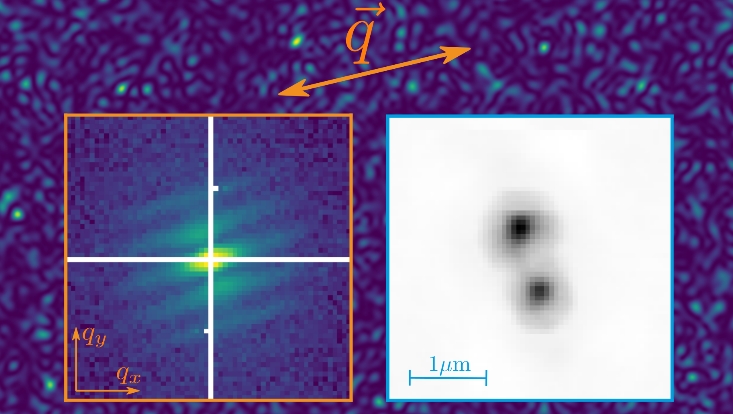Imaging of Matter
New imaging technique opens a new path
26 April 2023

Photo: Fabian Trost
An international research team has succeeded for the first time in using X-rays for an imaging technique that exploits a particular quantum property of light. As the researchers describe in their work just published in the journal Physical Review Letters, this technique could enable imaging of non-crystallized macromolecules.
The research team, led by Henry Chapman, professor at Universität Hamburg and leading scientist at DESY, used very intense X-ray free-electron pulses from the European XFEL to generate fluorescence photons that arrived almost simultaneously at the detector - within a time window shorter than a femtosecond. By computing photon-photon correlations of the X-ray fluorescence emitted by the atoms of a structure, images of the emission could be obtained.
The structures of materials and macromolecules, are usually determined at the atomic scale using X-ray crystallography. While that technique relies on coherent X-ray scattering, incoherent processes like fluorescence emission can dominate even though they do not usefully contribute to the diffraction measurement. Instead, they add a featureless fog or background to the measured data.
Structural information from fluorescence
In the 1950s, two astronomers demonstrated that it is indeed possible to extract structural information from the light emitted by self-luminous sources - in their case from stars. The method of Hanbury Brown and Twiss - called intensity interferometry - opened a new door into the understanding of light and started the field of quantum optics.
Recently, scientists from the University of Erlangen, the Max Planck Institute for the Structure and Dynamics of Matter and DESY proposed that intensity interferometry could be adapted for atomic-resolution imaging using X-ray fluorescence. The challenge in extending this idea to X-rays is that the coherence time of the photons, which dictates the time interval available to perform photon-photon correlations, is extremely brief. It is set by the radiative decay time of the excited atom, which for copper atoms is about 0.6 fs.
Now the group, together with scientists from Uppsala University and the European XFEL have overcome that challenge by using femtosecond-duration XFEL pulses from that facility to initiate X-ray fluorescence photons within the coherence time. They generated a source consisting of two fluorescing spots in a foil of copper and measured the fluorescence on a million-element detector placed 8 m away. Only about 5000 photons were detected on each illumination pulse, and the cumulative sum over 58 million shots gave just a featureless uniform distribution. However, when they instead summed photon-photon correlations, a fringe pattern emerged. Similar to the famous double-slit experiment of Thomas Young, this fringe pattern is the smoking gun that indicates interference of separate X-ray photons. This fringe pattern was then analyzed as if from a coherent wave field to reconstruct an image of the fluorescent source, consisting of two well-separated spots.
The photons carry hidden information
“Although the idea of interference of independent waves within the coherence time can be understood classically and can be noticed in the interference of radio stations for example, with X-rays we are very much dealing with high energy quanta”, says Henry Chapman, who is a researcher at the Cluster of Excellence “CUI: Advanced Imaging of Matter”. “Each fluorescence photon is born within a single atom, and these photons are then located at specific pixels of our detector. However, these photons carry hidden information that is only revealed when their higher-order photon-photon correlations are examined.”
The scientists now hope to combine this novel method with diffraction to image single molecules. The fluorescence will provide sub-structures specific to particular atoms and even particular chemical states of those atoms, which may help unravel the functioning of important enzymes such as involved in photosynthesis.
Citation
Fabian Trost, Kartik Ayyer, Mauro Prasciolu, Holger Fleckenstein, Miriam Barthelmess, Oleksandr Yefanov, J. Lukas Dresselhaus, Chufeng Li, Saša Bajt, Jerome Carnis, Tamme Wollweber, Abhishek Mall, Zhou Shen, Yulong Zhuang, Stefan Richter, Sebastian Karl, Sebastian Cardoch, Kajwal Kumar Patra, Johannes Möller, Alexey Zozulya, Roman Shayduk, Wei Lu, Felix Brauße, Bertram Friedrich, Ulrike Boesenberg, Ilia Petrov, Sergey Tomin, Marc Guetg, Anders Madsen, Nicusor Timneanu, Carl Caleman, Ralf Röhlsberger, Joachim von Zanthier, and Henry N. Chapman
“Imaging via Correlation of X-Ray Fluorescence Photons”
Phys. Rev. Lett. 130, 173201 (2023)
DOI: 10.1103/PhysRevLett.130.173201
More information: Physics Viewpoint


